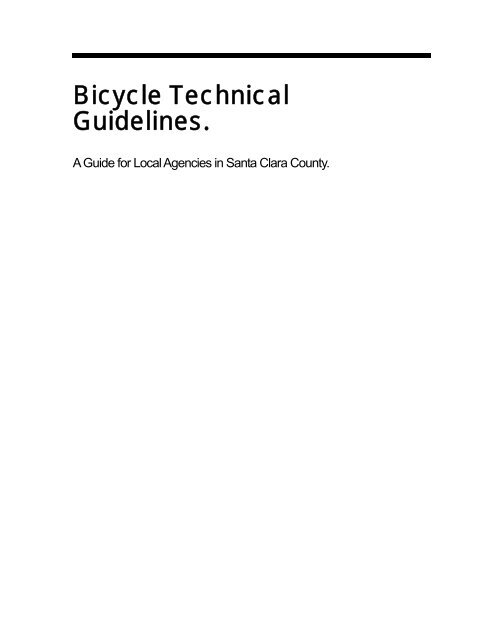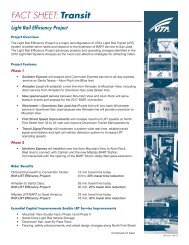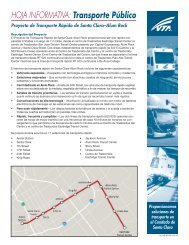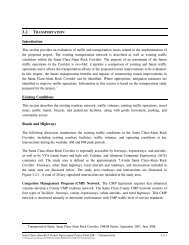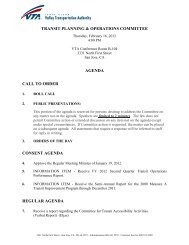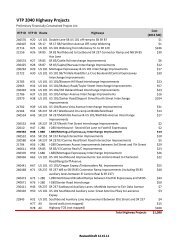Bicycle Technical Guidelines - VTA
Bicycle Technical Guidelines - VTA
Bicycle Technical Guidelines - VTA
Create successful ePaper yourself
Turn your PDF publications into a flip-book with our unique Google optimized e-Paper software.
<strong>Bicycle</strong> <strong>Technical</strong><br />
<strong>Guidelines</strong>.<br />
A Guide for Local Agencies in Santa Clara County.
<strong>Bicycle</strong> <strong>Technical</strong> <strong>Guidelines</strong><br />
A Guide for Local Agencies in the Planning, Design and Maintenance<br />
of <strong>Bicycle</strong> Facilities and <strong>Bicycle</strong>-Friendly Roadways<br />
Prepared by the<br />
Santa Clara Valley Transportation Authority<br />
Adopted September 2, 1999<br />
Revision 1 adopted December 13, 2007
HOW TO OBTAIN THE CURRENT <strong>VTA</strong> BICYCLE TECHNICAL<br />
GUIDELINES (BTG)<br />
The current version of the BTG is available on the <strong>VTA</strong> website at<br />
http://www.vta.org/schedules/bike_information.html. Pages are updated individually as the<br />
need arises; individual pages should be downloaded by holders of this manual as needed.<br />
Sign up to receive an email notice of future revisions by sending an email to bikes@vta.org.<br />
Revisions to the Board-adopted version of the December 13, 2007 BTG are itemized below.<br />
Date Effective Page Section and Topic Change<br />
No revisions No revisions No revisions No revisions<br />
Form<br />
As in the Highway Design Manual (HDM), the loose-leaf form was chosen for the BTG<br />
because it facilitates change and expansion. New guidelines will be issued as pages in the<br />
format of this manual; these may consist of additional pages or new pages to be substituted<br />
for those superseded.<br />
Reproduction<br />
This document may be reprinted whole or in part from the <strong>VTA</strong> website cited above for the<br />
sole use and purpose of conducting bike-friendly planning and design. If any part of this<br />
document is reproduced for this purpose, cite <strong>VTA</strong> <strong>Bicycle</strong> <strong>Technical</strong> <strong>Guidelines</strong> and the<br />
date as the source. No part of this work may be used or reproduced in any form, electronic,<br />
graphic, or mechanical, for marketing or other commercial purpose of any public or private<br />
agency or entity or for any reason other than that cited above.
BICYCLE TECHNICAL GUIDELINES<br />
TABLE OF CONTENTS<br />
Part I – General Guidance<br />
Chapter 1 Purpose and Policy Guidance<br />
1.1 Organization of Manual.............................................................................................1-1<br />
1.2 Who Uses These <strong>Guidelines</strong>....................................................................................1-4<br />
1.3 Relation to Other Design Manuals ..........................................................................1-4<br />
1.4 Consistency with Existing Policies ..........................................................................1-6<br />
Chapter 2 <strong>Bicycle</strong> Characteristics<br />
2.1 Defining Optimum, Should and Shall ......................................................................2-1<br />
2.2 <strong>Bicycle</strong> User Types ..................................................................................................2-1<br />
2.3 Facility Types and <strong>Bicycle</strong> Users .............................................................................2-2<br />
2.4 Operating Space of a Typical Bicyclist ....................................................................2-3<br />
Part II – <strong>Technical</strong> <strong>Guidelines</strong> for All Roadways<br />
Chapter 3 Roadway Design Elements<br />
3.1 Roadway and Lane Width ......................................................................................3-1<br />
3.2 Drainage Inlets and Gutters Pan..............................................................................3-2<br />
3.3 Pavement Marking Materials ...................................................................................3-4<br />
3.4 Roadway Surface Obstacles ...................................................................................3-5<br />
3.5 Signage Usage and Design .....................................................................................3-8<br />
Chapter 4 Maintenance and Construction Zones<br />
4.1 Roadway Resurfacing ............................................................................................4-1<br />
4.2 Roadway Patching and Utility Trenching Repair ....................................................4-2<br />
4.3 Ponding ....................................................................................................................4-3<br />
4.4 Sweeping .................................................................................................................4-3<br />
4.5 Landscape Maintenance .........................................................................................4-3
4.6 Construction Zones and Detours ............................................................................4-4<br />
Chapter 5 Intersections and Interchanges<br />
5.1 Right-turning Conflicts ............................................................................................5-1<br />
5.2 Left-turning Conflicts ................................................................................................5-5<br />
5.3 Freeway Interchanges .............................................................................................5-6<br />
Chapter 6 Signalized Intersections<br />
6.1 Traffic Signal Timing ...............................................................................................6-1<br />
6.2 Traffic Signal Detection ............................................................................................6-5<br />
6.3 <strong>Bicycle</strong> Signal Heads ...............................................................................................6-8<br />
Part III – <strong>Technical</strong> <strong>Guidelines</strong> For Bikeways On Roadways<br />
Chapter 7 Bikeways on Major Roads<br />
7.1 Bike Lanes ...............................................................................................................7-2<br />
7.2 Wide Curb Lanes .....................................................................................................7-9<br />
7.3 Sharrows ................................................................................................................7-10<br />
7.4 Shoulders on Rural Roads and State Highways ..................................................7-12<br />
Chapter 8 Local Roads as Bikeways<br />
8.1 Bike Routes and Signed Shared Roadways .........................................................8-2<br />
8.2 Bike Boulevards .......................................................................................................8-4<br />
8.3 Traffic Calming .........................................................................................................8-7<br />
Part IV – <strong>Technical</strong> <strong>Guidelines</strong> For Bike-Only Facilities<br />
Chapter 9 Bike Paths and Bike Bridges<br />
9.1 Bike Paths and Transportation Issues ...................................................................9-1<br />
9.2 Trail/Roadway Intersections ....................................................................................9-8<br />
9.3 <strong>Bicycle</strong>/Pedestrian Across Barrier Connections ...................................................9-10<br />
Chapter 10 Bike Parking<br />
10.1 Definitions ............................................................................................................10-1
List of Tables<br />
List of Figures<br />
10.2 Class 1 Bike Parking Options...............................................................................10-2<br />
10.3 Class 2 Bike Rack Options ..................................................................................10-6<br />
10.4 Placement Dimensions and Criteria ...................................................................10-8<br />
10.5 Bike Parking Quantity ........................................................................................10-13<br />
10.6 Bike Parking Policies and <strong>Guidelines</strong> by Land Use Type ................................10-15<br />
Table 1-1: Design Standards and Guidance Manuals for Streets and Bikeways........1-2<br />
Table 2-1: Bicyclist Type by Skill Level by Trip Purpose ..............................................2-1<br />
Table 2-2: Bicyclist Type Versus Facility Type .............................................................2-2<br />
Table 3-1: Optimum Bike Lane Widths .........................................................................3-1<br />
Table 4-1: Optimal Maintenance Frequencies for Roads and Trails .......................... 4-3<br />
Table 4-2: Bikeway Closure Evaluation Questions ......................................................4-5<br />
Table 6-1: Representative Bicyclist Speeds .................................................................6-1<br />
Table 10-1: Bike Locker Variations and Management Strategies .............................10-2<br />
Table 10-2: Bike Stations/Bike Rooms Management Strategies ...............................10-5<br />
Table 10-3: <strong>Bicycle</strong> Parking Supply Recommendations ..........................................10-14<br />
Figure 2-1: Bicyclist Essential Operating Space ...........................................................2-3<br />
Figure 2-2: Stationary Bicyclist with Trailer ...................................................................2-3<br />
Figure 2-3: Bicyclist on Two-Way Path - Essential Operating Space ..........................2-4<br />
Figure 3-1: Bikeway Crossing Skewed Railroad Tracks ..............................................3-6<br />
Figure 3-2: Rail Flangeway Filler Options ....................................................................3-6<br />
Figure 4-1: Wedge Cut for Roadway Resurfacing ........................................................4-1<br />
Figure 4-2: Trenching and Compacting Procedures ....................................................4-2<br />
Figure 4-3: Bike Detour Plan for Closed Street or Path ...............................................4-5<br />
Figure 5-1: Right-Turn Channelization Island .............................................................. 5-2<br />
Figure 5-2 Bike Lane at Free Right-Turn Lane ............................................................ 5-3
Figure 5-3: Double Right-turn Lane .............................................................................. 5-4<br />
Figure 5-4: Left-turn Options for Bicyclists ................................................................... 5-5<br />
Figure 5-5: Typical Local Street/Freeway Interchanges .............................................. 5-6<br />
Figure 5-6: <strong>VTA</strong> Best Practice Freeway Interchange.................................................. 5-7<br />
Figure 5-7: HDM Figure 1003.2D - Bike Lanes Through Interchanges ...................... 5-8<br />
Figure 5-8: Freeway On-ramp with Bike Lane and Exclusive Right-turn Lane: Added Rightturn<br />
Lane…………………………………………………………………………… 5-9<br />
Figure 5-9: Freeway On-ramp with Bike Lane and Exclusive Right-turn Lane: Trap Lane-<br />
Lane drop .......... ………………………………………………………………….5-10<br />
Figure 5-10: Arterial with Acceleration/Deceleration Lane ........................................ 5-11<br />
Figure 5-11: Bike-Friendly Retrofit of Freeway Off-ramp .......................................... 5-13<br />
Figure 5-12: Grade-Separated Intersection of Two Highways - <strong>Bicycle</strong>s<br />
Permitted…………………………………………………………………………………5-15<br />
Figure 6-1: Detector Type SA Details ......................................................................... 6-6<br />
Figure 6-2: Detector Layout at Five-Phase Signalized Intersection ............................ 6-7<br />
Figure 7-1a: Bike Lane Width - 30 mph or less Posted Speed ................................... 7-2<br />
Figure 7-1b: Bike Lane Width - 35-40 mph Posted Speed ......................................... 7-2<br />
Figure 7-1c: Bike Lane Width - 45 mph or more Posted Speed ................................. 7-3<br />
Figure 7-2: Bike Lane Striping Options with On-street Parking ................................... 7-3<br />
Figure 7-3: Bike Lane Striping Option at Intersection Approach ................................. 7-4<br />
Figure 7-4: Bike Lane Striping at Right-turn Only Lane ............................................... 7-5<br />
Figure 7-5: Bike Lane Striping at T-Intersection with Right-turn and Left-turn Lanes<br />
……………………………………………………………………………………………... 7-5<br />
Figure 7-6: Bike Lane Striping at Left-turn Only Lane ................................................. 7-5<br />
Figure 7-7: Bike Lane Striping and Detector Layout at Signalized Intersection Approach<br />
........................................................................................................................................ 7-6<br />
Figure 7-8: Loop Detector Pavement Marking.............................................................. 7-7<br />
Figure 7-10: Bike Lanes on Bus Routes ...................................................................... 7-8<br />
Figure 7-11: <strong>Bicycle</strong> Operating Space in Typical Travel Lane .................................... 7-9<br />
Figure 7-12: Typical Sharrow Pavement Marking Installation ................................... 7-11<br />
Figure 7-13: Shoulder Rumble Strip Details .............................................................. 7-12
Figure 7-14: Wide Shoulders - <strong>Bicycle</strong> Friendly Details ............................................ 7-14<br />
Figure 8-1: <strong>Bicycle</strong> Boulevard Typical Treatment ........................................................ 8-5<br />
Figure 8-2: Barrier Design: <strong>Bicycle</strong> Boulevard ............................................................. 8-6<br />
Figure 8-3: Forced Right-Turn Channelization ............................................................ 8-6<br />
Figure 8-4: Sinusoidal Speed Hump ............................................................................ 8-7<br />
Figure 9-1: Right-of-Way Width Allocation for Typical Bike Path ................................ 9-6<br />
Figure 9-2: Bike Path Width Allocation in Constrained Right-of-Way ......................... 9-7<br />
Figure 9-3: Traffic Control Option at Trail Intersections ............................................... 9-9<br />
Figure 9-4: <strong>Guidelines</strong> for Traffic Control Devices at Trail Intersections ..................... 9-9<br />
Figure 9-5: Typical <strong>Bicycle</strong> Bridge Cross Section ...................................................... 9-11<br />
Figure 10-1: Typical Dimensions - Inverted U and Variations ................................... 10-6<br />
Figure 10-2: Bike Rack Design Options ..................................................................... 10-7<br />
Figure 10-3: Bike Locker Placement Criteria ............................................................. 10-8<br />
Figure 10-4: Bike Rack Placement Criteria - Plazas or Near Buildings .................... 10-9<br />
Figure 10-5: Bike Rack Placement Criteria - Adjacent to Curb ............................... 10-10<br />
Figure 10-6: Bike Rack Placement Criteria - On-Street Parking Space ................. 10-11<br />
Detailed Issue Discussion<br />
Detour Evaluation Examples ...................................................................................... 4-7<br />
Signal Timing Example ................................................................................................. 6-4<br />
Potential Issues Related to 24-hour Access on Bike Paths ........................................ 9-4<br />
Discussion on Railing Height ...................................................................................... 9-12<br />
Appendix A <strong>Bicycle</strong> Transportation Policies and Statues<br />
1. California Vehicle Code Sections 21960 and 23330<br />
2. California Streets and Highways Code Section 887-894<br />
3. California Assembly Concurrent Resolution<br />
4. Caltrans Deputy Directive 64, 3-26-01<br />
5. Caltrans Director’s Policy Context Sensitive Solutions, 1-29-01<br />
Appendix B MTC Resolution #3765 Routine Accommodation
Appendix C Discontinued Signs in the MUTCD (CA)<br />
1. Table I-102 (CA) Deleted California Signs; - No Target Compliance Date<br />
2. Table I-103 (CA) Deleted MUTCD Signs; - No Target Compliance Dates<br />
Appendix D <strong>Bicycle</strong> Signal Head Warrants per MUTCD (CA)<br />
Appendix E Trail Design Checklists<br />
1. Trail Review Checklist from the Contra Costa County Trail Review Study<br />
2. Figure 9-1 Ramp Design from the Contra Costa County Trail Design Resource Handbook<br />
March 2001<br />
Appendix F Acronyms<br />
Acknowledgements
FOREWORD<br />
The <strong>VTA</strong> <strong>Bicycle</strong> <strong>Technical</strong> <strong>Guidelines</strong> (BTG) reproduce many of the Caltrans Highway<br />
Design Manual’s (HDM) standards and guidelines as well as those from other manuals. The<br />
BTG are intended to supplement and augment these manuals, by providing guidance on<br />
when and how to better accommodate the many types of bicyclists; to the extent that the<br />
Caltrans standard is a “minimum” dimension or practice, this manual presents best practice<br />
options for some situations. The <strong>VTA</strong> “Best Practices” included herein are not a substitute for<br />
professional engineering judgment and may not be appropriate for a specific situation. As<br />
with the HDM, the BTG is not a substitute for engineering knowledge, experience, or<br />
judgment. Reference to and knowledge of the original design manuals is assumed. Since<br />
the Highway Design Manual is the primary manual for bikeway design in California, the<br />
purpose of the HDM has been reprinted below and is hereby incorporated.<br />
Purpose (from the Foreword to the Caltrans Highway Design Manual)<br />
This manual was prepared by the Division of Design for Project Delivery.<br />
The manual establishes uniform policies and procedures to carry out the highway design<br />
functions of the California Department of Transportation (Department). It is neither intended<br />
as, nor does it establish, a legal standard for these functions. The policies established herein<br />
are for the information and guidance of the officers and employees of the Department. Many<br />
of the instructions given herein are subject to amendment as conditions and experience<br />
seems to warrant. Special situations may call for variation from policies and procedures,<br />
subject to Division of Design approval, or such other approval as may be specifically<br />
provided for in the text. It is not intended that any standard of conduct or duty toward the<br />
public shall be created or imposed by the publication of the manual. Statements as to the<br />
duties and responsibilities of any given classification of officers or employees mentioned<br />
herein refer solely to duties or responsibilities owed by these in such classification to their<br />
superiors. However, in their official contacts, each employee should recognize the necessity<br />
for good relations with the public.


